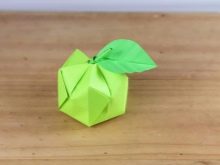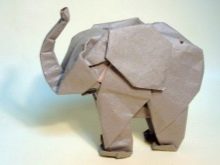The history of the origin and development of origami

This is an amazing fact, but the very concept of "origami", which we use today, was actually invented only in 1880. Prior to this, oriental paper crafts were called "orikata" (which literally meant "figures that are folded"). Origami is extremely popular in Japan, in many other Asian countries, including China, and this technique is known all over the world today.

Who invented origami and when?
Origami is a kind of arts and crafts, the country of origin of which is Ancient China. It was here that paper was invented at one time, and this is the main material from which creative figures are created. The name of the technique comes from the Japanese terms "ori" - "addition" and "kami" - paper (sometimes translated as "god"). At its core, origami is the skillful creation of all kinds of figures from a special type of paper for children and adults.
At first, such figurines were used for religious purposes and therefore only monks and representatives of the nobility knew how to make them. It was assumed that all people with a high position in society should be able to form such crafts from paper. Thus, many centuries ago this occupation was considered prestigious. The emergence of this art made it possible to spread this cultural tradition throughout the world.

The most rapid development and active popularization of origami took place in Japan. The Japanese, already during the Heian Dynasty, which existed from 794 to 1185, often used various paper figures for various ceremonies. For example, samurai presented to each other certain symbols of good luck in the form of ribbons from a paper base. Origami was also often seen at weddings: on the eve of the event, many paper moths were created for the newlyweds.

This art in the Middle Ages was found in other countries, and not only Asian, but also European.
In Europe, unfortunately, not too much information has been preserved about how the art of adding figures from a paper base developed. However, it is known for certain that, for example, the Arabs began to make origami already in the middle of the 8th century, the Moors brought this technique to the Iberian Peninsula in the 9th century. The Germans began to create neat figurines as early as the 15th-16th centuries. In European countries, origami was also used in ceremonies. But this original art became truly fashionable in Europe only around the 17th-18th centuries, at that time many classical techniques were already known. In the 19th century, origami received a new round of frenzied demand. Friedrich Froebel, creating educational institutions, suggested starting to use origami to help children develop the motor skills of small fingers.

Since the 60s of the XX century, origami has become a fashionable trend in art almost everywhere, special schools and circles taught Europeans to fold simple and complex figures of people and animals from paper. At the same time, such an original kind of art as modular origami was invented. This technology was significantly different from the classics. In their usual form, origami figures are mostly flat and folded from a single piece of paper. In a modular technique, a figure will consist of a certain number of parts that are inserted into each other in the desired order. As a result, a volumetric product comes out.



Technological development
Classic origami crafts often look like flat figures - as a rule, these are various animals or objects that have only one front side and cannot stand upright on a flat surface. This technique is used to create cats and bears, snowmen and many other interesting figures. History says that every country in the world has its own characteristics of this interesting technique, depending on when it came to a particular country and how it was popularized.




For example, all children in Russia have been making paper boats or airplanes for many decades, not suspecting that these are popular figures from the simplified origami technique.
The most famous are the following techniques for creating creative figures from special paper.



Simplified origami
Simplified origami was invented by the English master John Smith. The peculiarity of this technique lies in the fact that during the formation of the figures, the master uses only the method of folding by "slide" and "valley". This style is great for aspiring artisans. There are no complex ideas that are typical of standard techniques. Simplified origami is a technique used to teach children this Asian art.


Pattern-based technique
A pattern is a development in the form of a clear drawing, it is according to it that the future figure will be formed (all the existing elements and folds of the future figure are applied here). You just have to give the shape to the selected shape. But many experts still find this technique difficult for beginners. Thanks to this original method, you can fold the figure itself, and, if necessary, find out exactly how it was made. For this reason, patterns are used in the development of modern prototypes.



Wet origami technique
It was invented by a skilled craftsman named Akira Yoshizawa. He just decided to use a small amount of water to give the paper material plasticity. With the help of liquid, paper figures begin to acquire the desired smoothness of lines, their features become much more expressive and rigid.

This method should be used for figurines of plants or animals, as they are considered more complex.... In addition, thanks to the "wet" folding technique, the finished figures look much more natural. For this method, a special thick paper is used, at its base there is a special glue. With its help, the fibers of the paper will be better connected with each other.



Kusudama
This is a variation of the popular modular origami. The essence of the work is collecting figures in the form of a ball from paper parts-cones. In order for the final figurine to be strong, these parts are usually sewn together well. Using this technique, you can create simply stunning compositions of paper flowers and decorate the interior of any home with them.



Art in modern times
The heyday of origami all over the world began immediately after the end of the war in 1945, when origami, along with American soldiers, first came to the United States, and a little later - to many European countries.
By the way, art similar to origami sometimes appeared independently in various countries. For example, the school of paper figures in Spain is known, it is associated with the name of Miguel Umanum. This school at one time extended its technique of folding paper figures even to the countries of Latin America. Residents of Spain came up with their own method of creating classic paper figures, and in addition, they invented a fundamentally new method (the method of creating paper birds "plowing").


The art of origami appeared on French territory towards the end of the 19th century and was actively used by magicians - in front of an enchanted audience, they made a small bird from a piece of plain white paper that flapped its wings.
Each country adopted the art of classical origami, taking into account its own national traditions.
In Holland, the creation of paper figurines is classified as arts and crafts; it stands there on a par with embroidery and macrame knitting.
In Russia, origami technology is being tested as one of the teaching methods in kindergartens and schools.... Teachers conduct classes with the kids, showing them how to fold various crafts from a special paper base. This type of creativity allows you to develop not only fine motor skills, but also thinking, as well as memory, logic.

All traditional origami have a square base. However, today you can easily find such models that are composed of a triangle, rectangle, polygon.

Interesting Facts
It is believed that the very first edition about origami was published in 1797, it was distinguished by the loud-speaking name "Sembazuku orikata" ("How to Build 1000 Cranes"). The author of the treatise, Akisato Rito, described in it not so much different ways of forming figures, but rather focused on the cultural traditions of his distant country.

In the "Guinness Book of Records" you can find the most unusual achievements associated with the origami technique. There is a record for the most difficult origami, the most bulky figure, a very small model and many other records.



By the way, since 1999, the crane formed from a paper base has been a symbol of peace throughout the world. The most famous large paper crane was recently created. Its height exceeded 6 m, it weighed 794 kg. The crane was so huge that it had to be collected and shown to the audience in a large stadium.

Another experienced origami maker, Akira Naito, created the world's smallest crane out of a microscopic paper square with dimensions of 0.1x0.1mm. Akira had to carry out this painstaking work with the help of professional tweezers and a good microscope.
Usually Japanese figurines are created from a special kind of paper. Modern craftsmen can easily use ordinary wrapping paper for such purposes, sometimes you can find figurines from candy wrappers. Plain newsprint is often used. The most creative gift can be a figurine, neatly folded from a banknote.













